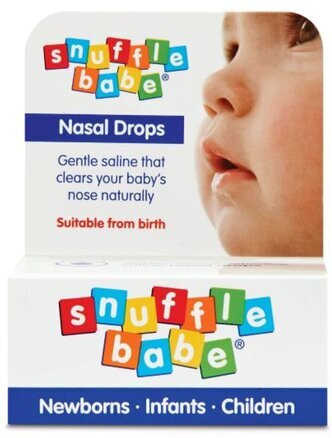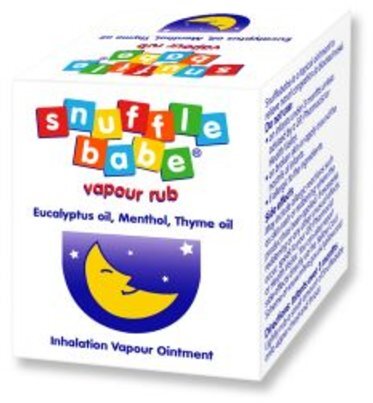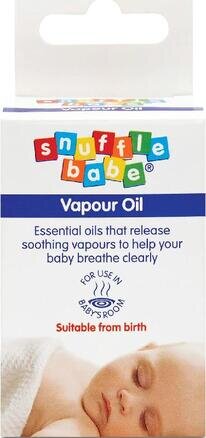SNUFFLEBABE nasal aspirator (cased)
SNUFFLEBABE nasal aspirator (cased)
Product features
Snufflebabe Nasal Aspirator is a paediatrician-approved nasal aspirator, used by health professionals, that is suitable for use from birth. It is a reusable device that uses a gentle suction method to remove mucus from your baby's nose. It comes with a protective filter that prevents any gunk from ever finding its way to your mouth. The Snufflebabe Nasal Aspirator is also available on prescription.
- Clear baby's nose instantly for clearer breathing
- Award winning medical device
- Handy storage case
Overview
If you're looking for a solution to physically clear mucus from your baby's nose, quickly and efficiently, this is it. The Snufflebabe nasal aspirator delivers instant relief for baby, while the visible mucus collects hygienically in the sealed chamber.
FAQ
What are some of the features of the Snufflebabe Nasal Aspirator?
Some of the features of the Snufflebabe Nasal Aspirator include:
- Paediatrician-approved
- Suitable for use from birth
- Reusable
- Gentle suction method
- Protective filter
- Available on prescription
How will the Snufflebabe Nasal Aspirator help?
- It can help to relieve nasal congestion and make it easier for your baby to breathe.
- It can help to prevent further complications such as ear infections, coughs, and stomach upsets.
- It is a safe and effective way to clear your baby's nostril.
- It is easy to use and clean.
How do you use the Snufflebabe nasal aspirator?
Here's how to use the Snufflebabe Nasal Aspirator:
Wash your hands thoroughly with soap and water.
- Fit the filter into the middle chamber of the aspirator.
- If the mucus is very dry, try moistening it with a saline solution or nasal spray.
- Gently insert the nozzle of the aspirator into the opening of one of your baby's nostrils. Do not push the nozzle into your baby's nose.
- Suck gently through the mouthpiece. You should see the mucus being drawn into the aspirator.
- Repeat steps 4 and 5 on the other nostril.
- Dispose of the mucus in a tissue or toilet.
- Clean the aspirator with soap and water. You can sterilise it by boiling it for 5 minutes.
- Here are some additional tips for using the Snufflebabe Nasal Aspirator:
Be gentle when using the aspirator. Do not suction too hard, as this could damage your baby's delicate nasal tissues.
- If your baby is fussy, try distracting them with a toy or by singing to them.
- If the mucus is very thick, you can try using a saline solution to moisten it. You can also try using a bulb syringe instead of the Snufflebabe Nasal Aspirator.
- Do not use the aspirator if your baby has a nosebleed.
- Sterilise the aspirator after each use to prevent the spread of germs.
Is the Snufflebabe Nasal Aspirator safe for my baby?
Yes, the Snufflebabe Nasal Aspirator is safe for your baby. It is a gentle hygienic suction method that does not harm the delicate tissues of the nose.
How often should I use the Snufflebabe Nasal Aspirator?
You can use the Snufflebabe Nasal Aspirator as often as needed, but it is generally recommended to use it no more than 2-3 times a day.
What if the mucus is too thick?
If the mucus is too thick, you can try moistening it with Snufflebabe nasal drops saline solution. You can also try using a bulb syringe instead of the Snufflebabe Nasal Aspirator.
How do I clean the Snufflebabe Nasal Aspirator?
To clean the Snufflebabe Nasal Aspirator, you can wash it with soap and water. You can also use the steam sterilising method, or sterilise it by boiling it for 5 minutes.
You can contact the Pharmacy Online team to discuss any concerns you may have about this aspirator.
Other
Info Leaflet
Before taking any medicines, regardless of whether they are over-the-counter or prescription-only, it is essential always to read the patient information leaflet.
Reviews
We Also Recommend
SNUFFLEBABE saline spray 15ml Out of stock
From £4.25SNUFFLEBABE nasal drops 10ml In stock
From £3.20SNUFFLEBABE vapour oil 10ml In stock
£6.99 (Save 10%)Was £7.80











